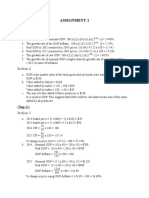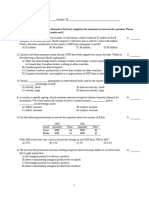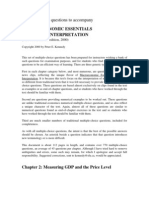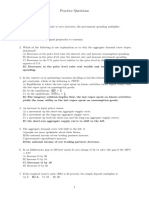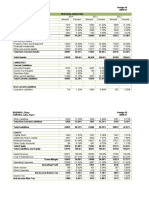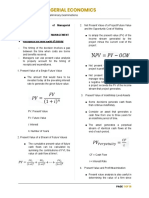MCQs - Answer Key
MCQs - Answer Key
Uploaded by
Nikhil AdhavanCopyright:
Available Formats
MCQs - Answer Key
MCQs - Answer Key
Uploaded by
Nikhil AdhavanCopyright
Available Formats
Share this document
Did you find this document useful?
Is this content inappropriate?
Copyright:
Available Formats
MCQs - Answer Key
MCQs - Answer Key
Uploaded by
Nikhil AdhavanCopyright:
Available Formats
+923443903583 MCQs Answer Key @adilusmanzoberi
MCQs – Wealth and income inequality
1) B
This is the correct description of a Gini coefficient. It should not be confused with A, which refers to
wealth inequality. C and D are off the point.
2) C
A lower Gini coefficient indicates a more equal distribution of income. B and D are incorrect as they
are outside the specific scope of the Gini coefficient. A is not correct as the income distribution in
Zambia is more equal than in Botswana.
3) C
The key to reaching the correct answer is to be very clear that a progressive income tax seeks to make
the distribution of income more equal. A sales tax is regressive. This last point should then rule out A
and B. Looking at C and D together, D would not produce a more equal distribution of income since a
lowering of the top rate of income tax would give more money to top earners.
4) D
Remember this question is about ‘wealth’, not income. This should immediately rule out A, B, and C
since these policies are designed to achieve a more equal distribution of income.
5) D
A lower-middle-income country is likely to have a large elderly population. Providing free meals to
this group is a way of increasing their real incomes. The benefits of the other options are less
quantifiable.
6) D
A more equitable distribution of income and wealth provides an incentive for people to work harder.
They can see the inequality gap narrowing. The other options contain too many uncertainties.
From the desk of Adil Usman Page |1
+923443903583 MCQs Answer Key @adilusmanzoberi
MCQs – National Income Statistics
1) D
A, B, and C are all measures of GDP and are different ways of measuring what is produced in a country.
In contrast, wealth is a stock of assets that have been built up over time.
2) B
Net property income from abroad includes profit, interest and dividends.
3) B
Net income from abroad is included in GNI but not GDP. If there is no property income from abroad, the
two measures would be equal. Both measures are adjusted for indirect taxes and subsidies. Transfer
payments are not included in either measure.
4) C
$500bn − $20bn. This converts GNI at basic prices to GDP at basic prices. $480 + $40bn − $10bn change
GDP at basic prices to GDP at market prices. Unemployment benefits are transfer payments and so are
not included in either GNI at basic prices or GDP at market prices.
5) C
GNI is GDP plus net income from abroad. If net income from abroad is negative, a figure would be
deducted from GDP. Capital goods, consumer goods, net exports, and indirect taxes are treated the same
in GDP at basic prices and GNI at basic prices.
6) B
There is a loss of $200 000 from loss of initial jobs but an extra plus $108 000 from the new jobs gained.
A state pension and unemployment as transfer payments and so are not included.
7) D
GDP, measured by the expenditure method, is consumer expenditure, government spending,
investment and net exports. In this case, this is $490bn + $80bn + $100bn + ($50bn - ?) = $640bn.
8) A
To convert from basic prices to market prices, indirect taxes are added and subsidies are deducted. To
go from net to gross, depreciation has to be added and to go from national income to domestic income,
net income from abroad has to be deducted.
9) C
Consumer expenditure plus investment plus government spending plus expenditure minus imports is
GDP at market prices. In this case, this is $700bn + $2000bn + $100bn − $50bn = $950bn. GDP at
market prices – indirect taxes and subsidies = GDP at basic prices. Here this is $950bn - $30bn + $15bn
= $935bn. A is NDP at basic prices, B is NNI at market prices and D is GNP at basic prices.
10) C
In calculating GDP by the output method, it is important to avoid double counting. Measuring the value
of finished products would mean that image processors would already have been counted in the output
of the smartphones industry.
From the desk of Adil Usman Page |2
+923443903583 MCQs Answer Key @adilusmanzoberi
MCQs – Circular Flow of Income
1) C
Injections add to a country’s income, output and expenditure. As leakages reduce a country’s income,
output and expenditure, a fall in leakages will effectively act as an injection. For example, if injections
were initially $50bn and leakages were $40bn, there would be a net injection into the circular flow of
$10bn. If then leakages fall to $30bn, there would be a net injection of $20bn.
2) B
Leakages involve income that leaves the circular flow of income. This means that it is income which is
not used to purchase the country’s goods and services.
3) C
A, B and D are all injections. C is a leakage.
4) D
Spending by Mauritian firms on capital goods from France involves importing goods into Mauritius and
so is a leakage. A and B are flows of income within the circular flow of Mauritius. C is an injection of
government spending.
5) B
The economy is in equilibrium when injections equal leakages, that is when G + I + X = S + T + M. In
this case, this is $90bn + ? + $60bn = $65bn + $75bn + $50bn. So $150bn + ? = $190bn.
6) D
An open economy has an international trade sector. It is also assumed that it will have a government
sector. All economies have households and forms.
7) B
An injection is an addition of spending that enters the circular flow. A is an example of a leakage and D
is a general description of a leakage. C arises within the circular flow.
8) D
Households provide their factor services to firms and pay for the products that firms sell them. A is two
flows from firms to households. B and C each have one flow from households to firms and one from
firms to households.
9) B
A decrease in tax on income will allow more to be spent. More spending will lead to more output and
more income. A is a decrease in an injection and C and D are leakages. A decrease in injection and an
increase in leakage will reduce the income flowing around an economy.
10) D
An open economy has three injections and three leakages. A would give equilibrium in a closed economy
without a government sector. B would give equilibrium in the unlikely situation of an economy that is
open to international trade but has no government sector. C would mean there is equilibrium in a closed
economy with a government sector.
From the desk of Adil Usman Page |3
+923443903583 MCQs Answer Key @adilusmanzoberi
MCQs – Economic Growth
1) D
Changes in real GDP show how a country’s output has altered over time. Real GDP can be measured in
terms not only of output but also income and expenditure. However, consumer expenditure is only one
component of total expenditure. Economic growth is often accompanied by a rise in living standards
but not in every case. Changes in population size indicate how population has grown or declined rather
than how the country’s output has changed.
2) D
Real GDP is adjusted for inflation whereas nominal GDP has not been. If growth in nominal GDP is the
same as the growth in real GDP, it must mean that no adjustment had to be made for inflation.
3) A
Economic growth caused by an increase in aggregate demand is shown by the movement of a
production point within a PPC towards or on to the PPC. An increase in a country’s productive capacity
is illustrated by a shift to the right of the PPC. A movement from a point on one curve to a point on or
inside a PPC to the right of the original one would show that both aggregate demand and productive
capacity have increased.
4) D
If a higher proportion of income is saved, consumer expenditure may fall, resulting in a slowdown in
economic growth. In the long run, more available funds for investment may make it easier and cheaper
to borrow. This could encourage more investment and an increase in economic growth. A decrease in
government spending on healthcare is likely to reduce output by lowering aggregate demand. It will
also be likely to reduce aggregate supply by lowering labour productivity. A decrease in the size of the
labour force would reduce productive capacity and the ability of the economy to produce goods and
services. An increase in the inflation rate will be likely to increase nominal GDP but may reduce real
GDP if it results in the country’s firms losing their price competitiveness.
5) A
A decrease in business optimism may reduce investment. It may also cause some firms to reduce their
output and dismiss some workers. Such actions would reduce aggregate demand which could lower the
price level. In contrast, B, C and D would all increase aggregate demand.
6) A
Advances in technology would increase aggregate supply. This may reduce the price level and increase
output. In contrast, B, C and D would be likely to reduce aggregate demand which may cause deflation.
7) C
An increase in labour productivity would mean that more could be produced with fewer workers. For
unemployment not to increase, economic growth would have to match the increase in labour
productivity. A and B would tend to increase the demand for labour, D would reduce unemployment.
From the desk of Adil Usman Page |4
+923443903583 MCQs Answer Key @adilusmanzoberi
8) C
A rise in real GDP occurs when output rises. Higher output may reduce poverty but may also be
associated with greater income inequality. Higher output may be achieved as a result of aggregate
supply rising in line with aggregate demand and so the price level may not rise. An increase in
population, especially if it involves an increase in the working age population is likely to increase output.
This, however, may not occur if employment does not rise or if productivity falls.
9) C
There will always be an opportunity cost of higher government spending on one area. For example, the
government could have spent more on healthcare. Poverty may fall because some of the poor may gain
jobs or may receive higher state benefits because the government will receive higher tax revenue.
Unemployment is likely to fall as aggregate demand will be higher. With higher incomes and more
expenditure, tax revenue will rise without having to increase tax rates.
10) B
Some non-renewable resources will still be used up even if the level of output remains unchanged.
However, the rate of depletion will slow down. Unemployment may occur if output is unchanged as the
size of the labour force may be growing. A government is likely to want to increase real GDP per head
in order to raise the population’s living standards. Governments seek to increase rather than reduce
living standards.
From the desk of Adil Usman Page |5
+923443903583 MCQs Answer Key @adilusmanzoberi
MCQs – Unemployment
1) D
An increase in a country's unemployment rate, by definition, must mean that there is an increase in the
proportion of the labour force without jobs. A is a cause rather than a consequence of a rise in the
unemployment rate. In the case of B, the unemployed are not economically inactive. C – an increase in
the unemployment rate may mean an increase in the number of people unable to find jobs. However,
this is not always the case since there could be an increase in the unemployment rate and fewer people
unable to find jobs if the size of the labour force has fallen.
2) B
A fall in a country’s unemployment rate means greater utilisation of existing resources. This is shown
by a movement from within the PPC towards the PPC. A shows a change in the allocation of resources
with the economy operating at full employment. C shows an increase in productive capacity resulting
from an increase in the quantity or quality of resources. D indicates an increase in a country’s ability to
produce consumer goods due to, for instance, greater productivity of workers employed in the
consumer goods industries.
3) B
A reduction in gender discrimination in labour markets is likely to mean that more women will enter
the labour force. A rise in the size of the labour force could mean that both the number of people
employed and unemployed could rise. A, C and D would all reduce the size of the labour force.
4) B
Workers are frictionally unemployed when they are in between jobs. The farm workers may gain new
jobs when they find out about the job vacancies. A and C are examples of structural unemployment,
arising from changes in the pattern of demand (A) and the pattern of supply (C). D is an example of
cyclical unemployment.
5) A
Cyclical unemployment is caused by a decrease in aggregate demand.
6) C
One of the causes of frictional unemployment is information failure.
7) D
Structural unemployment occurs when workers who have lost their jobs due to changes in the structure
of the economy experience difficulties switching from one type of job to another type of job.
8) D
Output is sacrificed as a result of unemployment. A and B are financial costs of unemployment. In the
case of C, more not less leisure may be experienced as a result of unemployment.
From the desk of Adil Usman Page |6
+923443903583 MCQs Answer Key @adilusmanzoberi
9) C
Unemployment may give some people time to find a more suitable job. Unemployment is likely to
reduce tax revenue as incomes and spending are likely to decline. Wages are more likely to fall, or at
least remain unchanged as a result of unemployment especially if it is cyclical unemployment. The
existence of unemployment is also more likely to increase rather than reduce the number of
discouraged workers.
10) A
A decrease in government spending on unemployment benefits may reduce the time the unemployed
spend between jobs. They may have a greater incentive to find work. B, C and D are likely to increase
the frictional rate. A decrease in the quality of labour market information, unlike A, would increase
frictional unemployment. C may also increase frictional unemployment as higher income tax could
reduce the gap between paid work and unemployment benefits. An increase in trade union membership
might result in wages being pushed above the equilibrium level, and so causing some workers to lose
their jobs.
From the desk of Adil Usman Page |7
You might also like
- AP Macroeconomics Practice Exam 1Document12 pagesAP Macroeconomics Practice Exam 1Nguyễn Phương LiênNo ratings yet
- IGCSE Economics Self Assessment Chapter 26 AnswersDocument3 pagesIGCSE Economics Self Assessment Chapter 26 AnswersDesre100% (2)
- Midterm 1 Mock Exam With AnswersDocument9 pagesMidterm 1 Mock Exam With AnswersSally ZhuNo ratings yet
- Macro Assignment 1Document6 pagesMacro Assignment 1Khanh NguyễnNo ratings yet
- ECON 201 12/9/2003 Prof. Gordon: Final ExamDocument23 pagesECON 201 12/9/2003 Prof. Gordon: Final ExamManicks VelanNo ratings yet
- Part A-Multiple Choice Questions Answer ALL Questions On The MCQ Sheet Provided (1 Mark For Each CORRECT Answer)Document14 pagesPart A-Multiple Choice Questions Answer ALL Questions On The MCQ Sheet Provided (1 Mark For Each CORRECT Answer)ohohohoh12321No ratings yet
- Chapter 8 MCBDocument6 pagesChapter 8 MCBHunter KellettNo ratings yet
- Economics WorksheetDocument25 pagesEconomics WorksheetayaanmalikyaseenNo ratings yet
- Ieco MCQ Exam PracDocument8 pagesIeco MCQ Exam PracDuankai LinNo ratings yet
- Econ 203 Tt2Document7 pagesEcon 203 Tt2examkillerNo ratings yet
- Prac 3 BDocument9 pagesPrac 3 BsianhbgNo ratings yet
- Midterm2 v2Document12 pagesMidterm2 v2shaelyng34No ratings yet
- ASAL Econ CB Chapter 15 AnswersDocument2 pagesASAL Econ CB Chapter 15 Answersshampa79mondalNo ratings yet
- Practise MCDocument6 pagesPractise MCNick Chow100% (1)
- Surprise Quiz IDocument5 pagesSurprise Quiz I23pgp011No ratings yet
- Macro Practice Exam 1Document35 pagesMacro Practice Exam 1D DNo ratings yet
- AGE 2023 WB CH07 AnswersDocument5 pagesAGE 2023 WB CH07 AnswerslucindagracepNo ratings yet
- Intermediate Macro Economics - Assignment 1 PDFDocument12 pagesIntermediate Macro Economics - Assignment 1 PDFTriple HNo ratings yet
- Macroeconomics QuestionnaireDocument3 pagesMacroeconomics QuestionnaireAbhishek Gupta100% (1)
- ECON 102 Midterm1 SampleDocument5 pagesECON 102 Midterm1 SampleexamkillerNo ratings yet
- MT 2015Document9 pagesMT 2015Ismail Zahid OzaslanNo ratings yet
- Econ 3010 Final Exam Multiple Choice (100 Points)Document9 pagesEcon 3010 Final Exam Multiple Choice (100 Points)westsiderNo ratings yet
- Econ 1010 Final Practice-2Document7 pagesEcon 1010 Final Practice-2Simoné M. LusterNo ratings yet
- ECON 203 - Midterm - 2010F - AncaAlecsandru - Solution PDFDocument6 pagesECON 203 - Midterm - 2010F - AncaAlecsandru - Solution PDFexamkillerNo ratings yet
- Quiz BUSN 225 Section DDocument4 pagesQuiz BUSN 225 Section DAMNA SHARIF BAJWANo ratings yet
- 203 Sample Midterm2Document16 pages203 Sample Midterm2Annas GhafoorNo ratings yet
- Practice MCQ 1Document12 pagesPractice MCQ 1Mi ThưNo ratings yet
- Class QuizDocument5 pagesClass QuizJAMIL AHMEDNo ratings yet
- Student Copy Chapter 3 ECON 1950 Practice QuestionDocument13 pagesStudent Copy Chapter 3 ECON 1950 Practice QuestionSharvinNo ratings yet
- Econ2123 Practice1 SolutionDocument9 pagesEcon2123 Practice1 SolutionNgsNo ratings yet
- 4 MCQ QaDocument11 pages4 MCQ QaMrittika WadderNo ratings yet
- Ema3572 Ema2572 2019 NorDocument12 pagesEma3572 Ema2572 2019 NorPetrus DominguNo ratings yet
- PracticeMCQECO401 PDFDocument42 pagesPracticeMCQECO401 PDFSyed ShoaibNo ratings yet
- NMEC 102 202304 Economic Principles IIDocument7 pagesNMEC 102 202304 Economic Principles IIishimwelorcaNo ratings yet
- Ch03 PracticeDocument9 pagesCh03 PracticeNavin GolyanNo ratings yet
- Unit 3 Macroeconomics Test ReviewDocument10 pagesUnit 3 Macroeconomics Test Reviewinvoker14No ratings yet
- Final 2017Document9 pagesFinal 2017Ismail Zahid OzaslanNo ratings yet
- Quiz 1 2005Document7 pagesQuiz 1 2005astrocriteNo ratings yet
- MCQs With Solution For ECONS (Macro)Document38 pagesMCQs With Solution For ECONS (Macro)DzifahManteau100% (1)
- 311 Midterm2complete 220218answersDocument12 pages311 Midterm2complete 220218answersMapalo MwewaNo ratings yet
- Eco Paper 1Document9 pagesEco Paper 1emailrheadsouzaNo ratings yet
- Multiple Choiice 2nd SemDocument119 pagesMultiple Choiice 2nd SemMudit RokzzNo ratings yet
- ECON 203 Midterm 2012W AncaAlecsandru SolutionDocument8 pagesECON 203 Midterm 2012W AncaAlecsandru SolutionexamkillerNo ratings yet
- Aggregate Demand Exam QuestionsDocument6 pagesAggregate Demand Exam Questionsvngo0234No ratings yet
- Midterm 2019 FallDocument7 pagesMidterm 2019 Fallxawebe3444No ratings yet
- MCDocument127 pagesMCMadiha AshrafNo ratings yet
- A171 BEEB1013 - Soalan Final PDFDocument14 pagesA171 BEEB1013 - Soalan Final PDFSHAKTISHWARAN DEVARNo ratings yet
- ASAL Econ CB Chapter 41 AnswersDocument3 pagesASAL Econ CB Chapter 41 Answerstimothy.imannuelNo ratings yet
- IGCSE - Mock 2 Econ Paper 1 MCQDocument7 pagesIGCSE - Mock 2 Econ Paper 1 MCQTOMY PERIKOROTTE CHACKONo ratings yet
- Practice Questions FinalDocument3 pagesPractice Questions FinalAman SinghNo ratings yet
- Ch6+7 Macroecon Q'sDocument2 pagesCh6+7 Macroecon Q'sWilliam ZhouNo ratings yet
- MacroEconomics Test 2Document3 pagesMacroEconomics Test 2Alinaitwe GodfreyNo ratings yet
- Chapter5 QuizDocument3 pagesChapter5 QuizJoey YUNo ratings yet
- Fiscal Policy TutorialDocument44 pagesFiscal Policy TutorialKing DariusNo ratings yet
- Review Questions For Test 2 Key 2012Document10 pagesReview Questions For Test 2 Key 2012Zeke MerchantNo ratings yet
- IGCSE Economics Self Assessment Chapter 39 AnswersDocument3 pagesIGCSE Economics Self Assessment Chapter 39 AnswersDesreNo ratings yet
- Assignment 2Document8 pagesAssignment 2Hà ChiếnNo ratings yet
- ECON1220 1C1D Tutorial Exercise 3 (Week 5)Document3 pagesECON1220 1C1D Tutorial Exercise 3 (Week 5)Liz zzzNo ratings yet
- Summary of David A. Moss's A Concise Guide to Macroeconomics, Second EditionFrom EverandSummary of David A. Moss's A Concise Guide to Macroeconomics, Second EditionNo ratings yet
- MCQs - National Income StatisticsDocument3 pagesMCQs - National Income StatisticsNikhil AdhavanNo ratings yet
- MCQs - Economic GrowthDocument3 pagesMCQs - Economic GrowthNikhil AdhavanNo ratings yet
- 28.statistics Formulae - by Anand Kaku-1Document7 pages28.statistics Formulae - by Anand Kaku-1Nikhil AdhavanNo ratings yet
- 10.micro Eco by Titli AcademyDocument84 pages10.micro Eco by Titli AcademyNikhil AdhavanNo ratings yet
- 7.eco - Chalisa Handwritten by StudentDocument44 pages7.eco - Chalisa Handwritten by StudentNikhil AdhavanNo ratings yet
- 2.accounts LMR HandwrittenDocument56 pages2.accounts LMR HandwrittenNikhil AdhavanNo ratings yet
- Sunny Days Childrens T Shirt UsDocument5 pagesSunny Days Childrens T Shirt UsMelanie ManriquezNo ratings yet
- Data Sheet AM1011A A0Document10 pagesData Sheet AM1011A A0Saif BelloumiNo ratings yet
- Depreciation: Accountancy - II 1Document9 pagesDepreciation: Accountancy - II 1M JEEVARATHNAM NAIDUNo ratings yet
- Vertical AnalysisDocument5 pagesVertical AnalysisADRIANO, Glecy C.No ratings yet
- GR 11 Eco P1 (English) June 2023 Question PaperDocument12 pagesGR 11 Eco P1 (English) June 2023 Question Papernomvulapetunia460No ratings yet
- QA006 - Root Cause AnalysisDocument10 pagesQA006 - Root Cause Analysissubbu_281100% (2)
- Comparisonal Analysis of Formwork Costs ConventionDocument7 pagesComparisonal Analysis of Formwork Costs Conventionanildondapati1No ratings yet
- Section - 7 - Form of Bid Security - AppendixDocument15 pagesSection - 7 - Form of Bid Security - AppendixHaile AndargNo ratings yet
- Gbs Sip War FormatDocument4 pagesGbs Sip War FormatTechboy RahulNo ratings yet
- Small Scale Tamping MachineDocument6 pagesSmall Scale Tamping MachinejasonNo ratings yet
- Public Finance - Chapter 7 - Taxation and Economic EfficiencyDocument88 pagesPublic Finance - Chapter 7 - Taxation and Economic EfficiencyPhạm Trương Uyên ThyNo ratings yet
- Gohil's PPRDocument8 pagesGohil's PPRr09033No ratings yet
- Fees StructureDocument3 pagesFees StructureFightAgainst CorruptionNo ratings yet
- Economics AssingmentDocument13 pagesEconomics AssingmentRitasha MittalNo ratings yet
- Introduction To Engineering EconomyDocument15 pagesIntroduction To Engineering EconomyKetut PujaNo ratings yet
- Installing Tile On StairsDocument4 pagesInstalling Tile On StairsAuthmane DekNo ratings yet
- Chapter 3Document16 pagesChapter 3greenapl01No ratings yet
- Obc Rules of ObcDocument37 pagesObc Rules of ObcSanjivi Nathan100% (2)
- TASUED Post UTME Past Questions 3Document30 pagesTASUED Post UTME Past Questions 3olayiwola adewale100% (3)
- Bank Credit Card Default Prediction: Problem StatementDocument5 pagesBank Credit Card Default Prediction: Problem StatementRohit GhaiNo ratings yet
- Bahrain Economics ReportDocument40 pagesBahrain Economics ReportNawal AjNo ratings yet
- Tasma IiiDocument5 pagesTasma IiibalaNo ratings yet
- 1a9 Man Econ Prelims ReviewerDocument16 pages1a9 Man Econ Prelims ReviewerJhermaine LuisNo ratings yet
- Subject: Accountancy: Kendriya Vidyalaya Sangathan Guwahati RegionDocument170 pagesSubject: Accountancy: Kendriya Vidyalaya Sangathan Guwahati RegionHimangi AgarwalNo ratings yet
- Presentation by Knitting Machine PartDocument36 pagesPresentation by Knitting Machine PartEngineer WaleedNo ratings yet
- How To Make Hydraulic Powered Robotic Arm From CardboardDocument2 pagesHow To Make Hydraulic Powered Robotic Arm From Cardboarddavid firdausNo ratings yet
- Fuel Price HikeDocument10 pagesFuel Price HikeKrishna EtikaNo ratings yet
- CH 01Document14 pagesCH 01damaris ramosNo ratings yet
- CH 5 Budgetary Control & Responsibility AccountingDocument86 pagesCH 5 Budgetary Control & Responsibility AccountingIra AdraNo ratings yet
- Pile Cap DesignDocument10 pagesPile Cap DesignChristoper Dela CruzNo ratings yet



